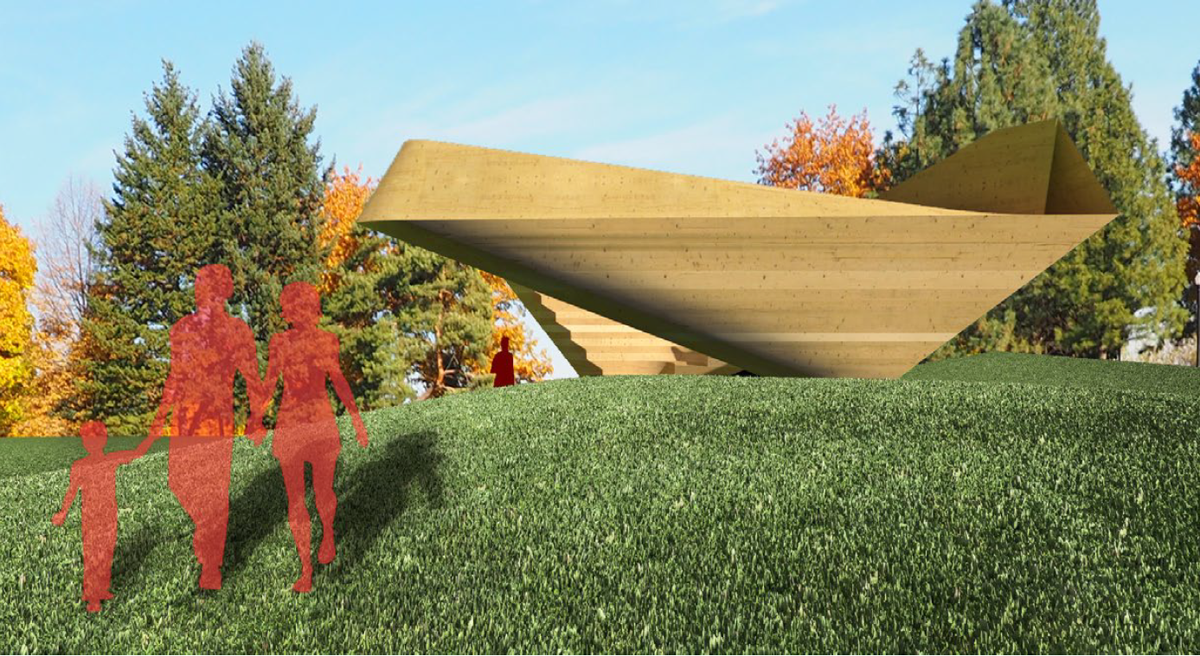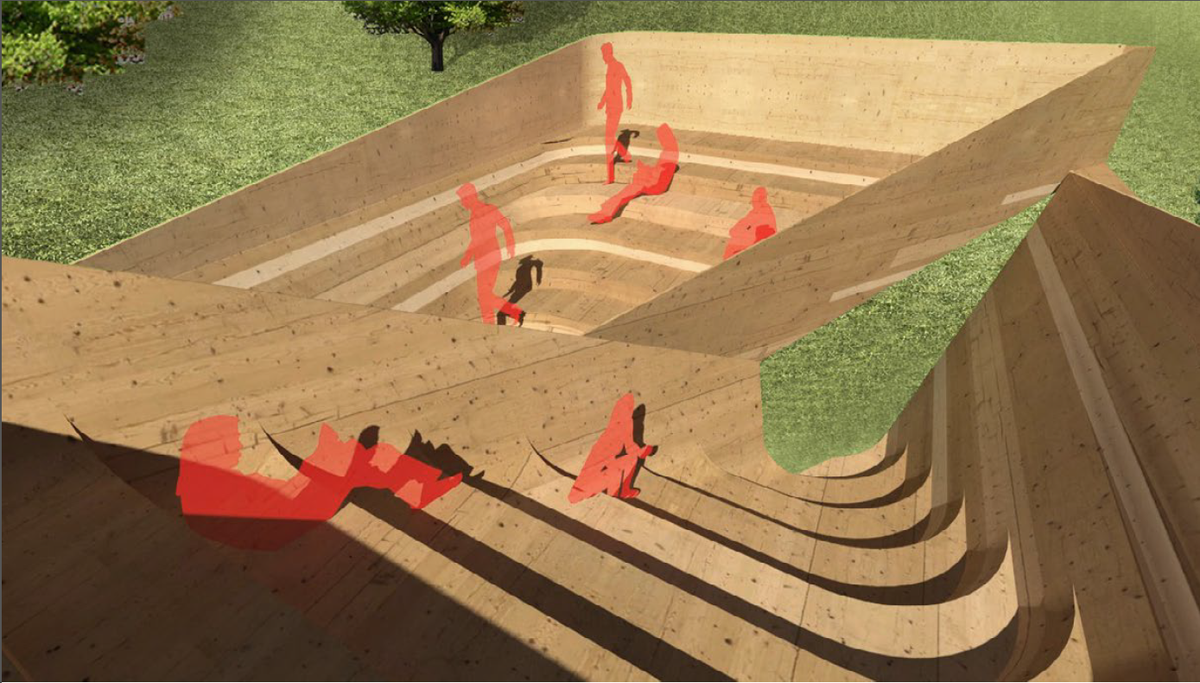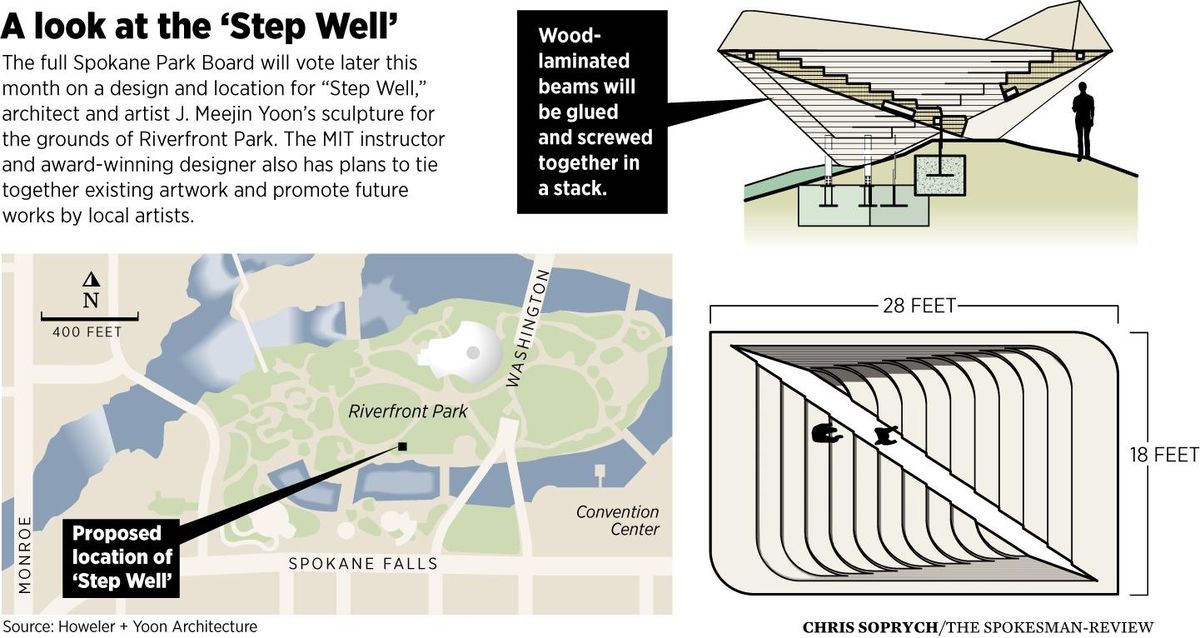Design of signature art for revitalized Riverfront Park set for vote
J. Meejin Yoon knew about the world’s fair in Spokane long before she won the contract to design the artistic future of its grounds.
The award-winning Korean-American artist and architect taught a course at the Massachusetts Institute of Technology on the globe-trotting expositions celebrating cultures, including Spokane’s fair in 1974. Her research for that course was Yoon’s first introduction to downtown’s 100-acre park that will serve as a canvas for her latest work.
“I thought it was really eclectic and diverse, to have such a natural, almost majestic landscape, bordered by architectural elements,” Yoon said in a phone interview this week from her office at MIT.
The Spokane Park Board is scheduled to vote later this month on the design and location of a proposed $360,000 laminated wooden structure known as “Step Well” that is part of Yoon’s plans for the park. The piece, which will be paid for with money set aside in the $64.3 million taxpayer-funded redevelopment of Riverfront Park, is slated for construction in the Clocktower Meadow, just north of the new building for the Looff Carrousel.
The 9-foot-tall structure would allow up to 75 visitors to scale wooden steps and peer across the river to the carrousel and downtown to the south or over the rolling meadow to the skyline of the U.S. Pavilion to the north. At 20 feet wide by 30 feet long, the installation would be larger than the Red Wagon “Childhood Express” sculpture designed by Ken Spiering for the 1989 Centennial Celebration of Children.
Like all her plans for the park, Yoon said the design for her piece was created with views of natural vistas in mind. The Cornell- and Harvard-educated designer has made a name for herself designing installations with her firm, Howeler & Yoon Architecture in Boston, that play with light and sound. That includes an installation at a U.S.-Mexico border crossing south of San Diego that uses the natural flow of traffic to display colors on interactive LED panels, finished in 2014.
“Step Well” is meant to provide a more contemplative experience, Yoon said.
“I thought, instead of a dynamic lighting display, that interaction would be better in that context, at that scale, more human-to-human, and human-to-landscape,” she said.
Members of the Spokane Park Board and representatives of the arts community recommended a design that uses angled railings that won’t obscure views at the top of the feature, though there was some discussion about the potential for safety issues in the park.
“Someone’s going to find a way to jump off of it, no matter what you do,” said Ted McGregor, who leads the Park Board committee overseeing the redevelopment of Riverfront Park, at a meeting discussing the designs last month at City Hall.
“If you are responsibly enjoying the sculpture, it’s going to be difficult,” Yoon responded.
Jennifer Ogden, a Park Board member who came to Spokane by way of the art scenes in King County and Boston, said she was struck by the natural beauty of the piece, which will be built using glued laminated timber, or glulam, wood.
“Meejin was taken with the drama of the landscape, and she felt she couldn’t improve upon nature’s perfection there,” Ogden said.
Yoon’s work also drew praise from David Evans, the chief site designer for Expo ’74 who recently moved back to Spokane after a 40-year absence.
“Meejin’s two art pieces are not so much ‘Look at me’ art, as they are art intended as places to experience the natural features and vistas of the land,” Evans wrote in an email. A second piece, called “Earth Ring,” would cost an estimated $1.5 million, and park planners have said they don’t have the budget right now to make that piece a reality.
If selected, the Step Well installation would be built to coincide with completion of the park’s redevelopment, expected in 2020, said Fianna Dickson, a spokeswoman for the city’s Parks Department. There’s no specific timeline for its construction.
Yoon was selected from a field of 80 applicants to not only create a signature art piece for the park, but also provide an overarching plan to highlight work already located there as well as promote future installations. Melissa Huggins, executive director of the nonprofit Spokane Arts, said her group recommended Yoon in 2016 because of her stated desire to make sure any art reflected the city and the culture of both the Expo and the native tribes who made the banks of the river their home for generations.
“I think that was the thing that really tipped the scales,” said Huggins, who was named head of the organization after Yoon’s selection but has been working closely with the artist on the plans for the park.
In addition to the siting and design of the Step Well piece, the Park Board will vote later this month whether to approve Yoon’s art plan for the park. That includes adding signs that will include background information on pieces such as Spiering’s Red Wagon, the Bloomsday runner statues designed by David Govedare, Sister Paula Turnbull’s Garbage Goat and Harold Balazs’ “Lantern” sculpture, among others.
“We see that master plan as very exciting,” Huggins said. “The significant artwork is the cool, sexy thing that everybody wants to comment on, focus on. The art markers are something that we’re really, nerd-ily, excited about.”
Yoon, who also is working on a suspended platform in Philadelphia’s Schuylkill River called “Floating Lab” and a monument in Charlottesville, Virginia, to the slaves who built what became the state’s public university, said her goal with the plan is to demonstrate the beauty not only created by Spokane artists, but of the green space brought out for the Expo more than 40 years ago.
“For me, it’s not about my legacy, but the understanding that Riverfront Park is a landscape for the public,” Yoon said. “I hope to enhance our awareness of the natural environment there.”


